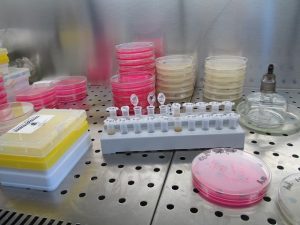Category: Featured News

Protein Identified As Target to Halt Spread of Mesothelioma and Other Cancers
Time and again mesothelioma patients discover that while their cancer treatment initially appeared effective, cancer cells slipped away and spread to other areas of their body. It is this metastasis that eludes scientists. Now, researchers report they have identified a protein they can target that will prevent the spread of cancer cells.
The LTBP3 protein, known to fuel blood vessel growth, in effect, spurs cancer cells to spread beyond the initial tumor site by traveling in these new “highways” through the body, according to a Feb. 16 press release from the Scripps Research Institute. Patients who had lower levels of this protein had a better prognosis, leading the researchers to focus on finding a way to target LTBP3.
The research team looked more closely at LTBP3 and TGFβ, a molecule that has been linked to both growth and suppression of cancer. They knew the two “partner” to regulate TGFβ, but they wanted to find if the two worked in concert to spread cancer. However, because TGFβ is both good and bad, they had to find a way to suppress the molecule’s harmful effects, without interfering with the benefits for slowing cancer growth.
Using chick embryo and mouse models, they suppressed LTBP3 and discovered that without it, primary tumor cells could not metastasize efficiently. This indicated that LTBP3 is involved very early in the metastasis process. The team concluded “LTBP3 levels can indicate better overall survival” in some cancer patients.
The team reports that LTBP3 is a good “upstream” drug target for early stage tumors without affecting the role of TGFβ. Their next step is to determine how LTBP3 and TGFβ partner in the induction of new blood vessels deep within a tumor.
Finding a way to halt the spread of deadly cancer cells is critical for improving survival in mesothelioma patients. In fact, according to the American Cancer Society, “With upwards of 90% of all cancer suffering and death associated with metastasis, it is the single most significant challenge to management of the disease.”
Nearly 3,000 Americans are diagnosed with mesothelioma each year. Finding an effective way to stop the cancer from spreading, as opposed to treating the cancer after it has spread, brings hope to the mesothelioma community.
Find out more about the Scripps study in the January 19 issue of Oncogene.
Sources:
- January 19 issue of Oncogene
https://www.nature.com/articles/s41388-017-0075-1
- Scripps Research Institute
https://www.scripps.edu/newsandviews/e_20180216/deryugina.html

Mesothelioma Patients Eye Combination Therapy Given FDA Priority Review for Bringing “Significant Survival Benefit” To Lung Cancer Patients
In October 2016, MesotheliomaHelp reported the U.S. Food and Drug Administration approved the immunotherapy drug atezolizumab (TECENTRIQ, Genentech Oncology) for the treatment of patients with metastatic non-small cell lung cancer (NSCLC) whose disease progressed after platinum-based chemotherapy. Now, Genentech reports the FDA has granted priority review for Tecentriq when used in combination with bevacizumab (Avastin), paclitaxel and carboplatin (chemotherapy), for lung cancer patients.
The status was given based on results from the Phase III IMpower150 study, according to the May 6 press release from Genentech announcing the approval. The trial was established to evaluate the safety and efficacy of Tecentriq with the triple drug combination compared with patients receiving the triplet without Tecentriq. Tecentriq is designed to target PD-L1 expressed on tumor cells and tumor-infiltrating immune cells and to enable the activation of T cells, according to the company.
“Our Phase III results showed TECENTRIQ in combination with Avastin, paclitaxel and carboplatin has the potential to provide a significant survival benefit in the initial treatment of metastatic non-squamous non-small cell lung cancer,” said Sandra Horning, M.D., chief medical officer and head of Global Product Development. “We are working closely with the FDA to bring this treatment regimen to people with this type of lung cancer as soon as possible.”
Lung cancer is by far the leading cause of cancer death among both men and women in the U.S., according to the American Cancer Society. The ACS estimates about 234,030 new cases of lung cancer will be diagnosed in 2018, with approximately 154,050 Americans dying from the cancer. Nearly 3,000 Americans are diagnosed with mesothelioma, with close to the same number losing their lives to it each year.
Pleural mesothelioma is an asbestos-caused cancer affecting the lining of the lungs. Although there are clinical differences between lung cancer and mesothelioma, the treatment protocol for the two cancers are similar. Mesothelioma is a terminal cancer with limited treatment options. Any new breakthrough or approval in the treatment of NSCLC is considered a win for mesothelioma patients as well.
A Priority Review designation will direct overall attention and resources to the evaluation of applications for drugs that, if approved, would be significant improvements in the safety or effectiveness of the treatment, diagnosis, or prevention of serious conditions when compared to standard applications, according to the FDA.
https://www.fda.gov/ForPatients/Approvals/Fast/ucm405405.htm
A Priority Review designation means FDA’s goal is to take action on an application within 6 months. Genentech reports the FDA is expected to make a decision on approval by September 5, 2018.
Find out more about the IMpower150 clinical trial at ClinicalTrials.gov.
https://clinicaltrials.gov/ct2/show/NCT02366143
Sources :
- Genentech
https://www.gene.com/media/press-releases/14715/2018-05-06/fda-grants-priority-review-to-genentechs - American Cancer Society
https://www.cancer.org/cancer/non-small-cell-lung-cancer/about/key-statistics.html

Chemicals Identified As Potential Targets for Lung Cancer May One Day Be Focus for Personalized Mesothelioma Treatments
After five years spent testing and retesting over 200,000 different compounds as candidates to be used in the treatment of lung cancer, researchers narrowed the list down to 170 chemicals. Now, the team plans to delve deeper into the mechanisms of the compounds and to assess the effectiveness against other types of cancers. Potentially, mesothelioma and other aggressive cancer patients will benefit from the new discovery.
The team of researchers from University of Texas Southwestern Medical Center, using the Center’s “unique lung cancer cell library,” set out to identify therapeutic triads, according to an April 19 press release. The search required testing against a trifecta of criteria including finding chemicals that kill cancer cells, biomarkers that predict who would respond, and the therapeutic targets on which those active chemicals work.
The 170 chemicals were tested against 100 lung cancer lines to confirm they all met the three sets of criteria. The resulting chemicals are called the Precision Oncology Probe Set, or POPS. This testing approach is considered unusual for cancer research with the team looking at drugs first, then cancers.
“Almost all cancer research is gene-first, or target-first. We began with the potential drugs,” said Dr. Michael Roth, Professor of Biochemistry and a member of the Simmons Cancer Center.
The researchers report that these findings are “a significant step forward toward personalizing cancer care.” They report that for most of the compounds they identified a biomarker that can lead to the development of precision medicine. This means patients with those biomarkers can receive individualized care.
Personalized care targeted to the unique characteristics, such as the biomarkers, of a mesothelioma patient increases the chance of success, and can extend their survival and improve their quality of life. For most mesothelioma patients, life expectancy is less than a year after diagnosis and they often struggle with daily living tasks. There is no cure, and there are limited treatments for the asbestos-caused cancer.
UT Southwestern researchers are known for their innovative approach to cancer research with their findings bringing hope to the mesothelioma community. MesotheliomaHelp has reported on UT’s research into chili peppers in combating cancer and into a new target in fighting the KRAS gene in cancer. They have also conducted mesothelioma clinical trials.
UT Southwestern Medical Center is one of the few institutions in the country with a treatment and research program dedicated to mesothelioma, according to its website. To find out more about UT Southwestern’s research and treatment for mesothelioma, visit the Mesothelioma program’s website.
Read the full study in the March 28 issue of the journal Cell.
https://www.cell.com/cell/fulltext/S0092-8674(18)30308-8
Sources
- University of Texas Southwestern Medical Center
http://www.utsouthwestern.edu/newsroom/articles/year-2018/170-lung-cancer-drugs.html - Mesothelioma program’s website
https://utswmed.org/conditions-treatments/mesothelioma/ - UT Southwestern Medical Center
https://utswmed.org/conditions-treatments/mesothelioma/

Drug Targeting Specific Protein Could Lead to Personalized Mesothelioma Treatment
Anti-cancer drugs known as kinase inhibitors have often been used in the treatment of pleural mesothelioma and many other cancers. The drugs attack the protein kinases in an effort to prevent cell division and to kill the cancerous cells. Now, researchers report they have found that an investigative drug can effectively shrink tumors in patients with lung cancer and other difficult to treat cancers with a specific kinase. Pleural mesothelioma patients could benefit as well.
According to researchers from The University of Texas MD Anderson Cancer Center, in the first-in-human study of the investigational, oral drug BLU-667, “the drug appears to be promising” in cancers caused by an alteration in the receptor tyrosine kinase known as RET, or rearranged during transfection. The drug is “a highly potent and selective RET inhibitor” shown to have limited toxicity in the patients.
“Tumor reductions and durable responses were observed in most patients, especially those patients whose cancer progressed with chemotherapy and multi-kinase inhibitors,” said Vivek Subbiah, M.D., Assistant professor of Investigational Cancer Therapeutics at MD Anderson Cancer Center, in an April 15 press release.
In the study of 43 patients with advanced tumors not eligible for surgery, 26 patients with thyroid cancer, 15 with non-small cell lung cancer, and two with other RET-driven cancers, the overall response rate was 37 percent for RET-driven cancers, with responses of 45 percent for non-small cell lung cancer and 32 percent for thyroid.
“Overall, the data show the precision targeted therapy with next-generation kinase inhibitors can have a powerful impact for patients with RET-driven cancers,” said Dr. Subbiah.
Kinases function as drivers for numerous types of cancer, including mesothelioma. Kinases are involved in the gradual transformation of normal tissue in the lining of the lung into malignant pleural mesothelioma after exposure to asbestos. Various kinase inhibitors have been used to treat mesothelioma and other cancers, but according to Dr. Subbiah, these “earlier generations of multiple kinase inhibitors” have limited success and come with significant side effects.”
Although researchers have made progress in recent years, identifying an effective treatment modality for the fatal mesothelioma remains elusive. Taking a personalized approach to the treatment of mesothelioma by targeting a patient’s unique genetic characteristics, such as the RET biomarker, offers the most effective treatment options.
“By offering a highly selective medicine tailored for this oncogenic driver, we hope this new therapy will enable patients to benefit from the recent advances in genomic profiling that have revolutionized treatment options for patients with kinase-driven diseases.”
Find the results of the study in the April 15 issue of Cancer Discovery.

Mesothelioma Community Ponders Significance of Newly Discovered Organ
For years, researchers have struggled to find the reason mesothelioma and other cancers aggressively grow and spread throughout the body. Primarily, the focus has been on the spread of cancer cells through the bloodstream. Now, researchers report they have discovered a new organ that could be responsible for unbridled cancer growth.
In a recent discovery, researchers from New York University’s School of Medicine report they found a new organ that sits one layer below the skin. The mesh-like interstitium, as it has been named, is a layer of interstitial tissue filled with and surrounded by interstitial fluid. Although they have known about the tissue and fluid, the way the tissue had been examined in the past, with the fluid removed, it was seen as just another piece of tissue.
According to a March 27 article in the CNN, when the researchers kept the tissue alive and examined it more closely, they found that it has a unitary structure with compartments filled with fluids. The researchers surmised some of the fluid is lymph fluid, of the lymphatic system that supports immunity, and flows through the body through these interconnected compartments. The flow of fluids can also spread diseases, including cancer.
Because the interstitium has a single structure and a single function, Neil Theise, a professor at NYU’s School of Medicine and author on the paper, says it meets the criterium to be considered an organ. The interstitium is throughout the body, like the skin, but he says, it is even larger than the skin.
Thiese believes the interstitium could change the way doctors think about cancer and other diseases. “It’s been known that when cancer invades this layer, either in the skin or in the viscera, that’s when it first becomes able to spread outside the organ of where it arose,” said Theise.
“This discovery will open up new research pathways for inflammation and cancer progression,” added Dr. Petros Constantinos Benias, co-lead author of the study, a member of the Feinstein Institute and an assistant professor at the Donald and Barbara Zucker School of Medicine at Hofstra/Northwell Health.
Mesothelioma is the signature cancer of asbestos caused by inflammation from inhaling the microscopic fibers. The cancer can spread rapidly, and treatments are focused on trying to halt metastasis. This new understanding of how the cancer may travel through the interstitium could lead to a new approach for halting cancer growth.
Much more research still needs to be conducted, but the team suggests that whereas currently blood and tissue samples are used as a diagnostic tool, interstitial fluids may be effective.
“We are optimistic that with what we learned, we’ll soon be able to study and target the interstitial space for diagnosis of disease and perhaps for novel personalized treatments,” said Dr. Benias.
Find the study in the March 27 issue of Scientific Reports.
Free Mesothelioma Patient & Treatment Guide
We’d like to offer you our in-depth guide, “A Patient’s Guide to Mesothelioma,” absolutely free of charge.
It contains a wealth of information and resources to help you better understand the condition, choose (and afford) appropriate treatment, and exercise your legal right to compensation.
Download Now